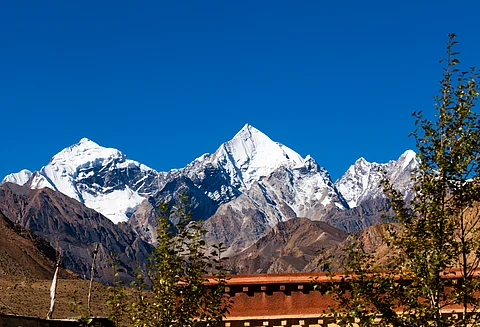
- Destinations
- Experiences
- Stay
- What's new
- Editor’s Picks
- Responsible Tourism
- CampaignsCampaigns
- Subscribe

Situated in the Pithoragarh district of Uttarakhand, Vyas Valley lies ensconced in the serene embrace of the Himalayas. The picturesque wilderness of the Vyas Valley, a stone-cold desert, is not only a geographical marvel but also a spiritual and cultural haven with deep historical significance. The natural site is known for its stark beauty and tranquil environment and has breathtaking landscapes, ancient heritage, and mystical charm. From snow-capped peaks and arid plains to sacred sites and quaint villages, Vyas Valley beckons adventurers, pilgrims and nature lovers to explore its myriad wonders. From history to myth and much more in between, here's what you should know before embarking on a trip.
Vyas Valley is named after the sage Vyasa, the legendary author of the "Mahabharata." According to mythology, it is believed that Vyasa meditated in the valley and that his presence imbued the area with sanctity. The valley has been a crucial part of ancient trade routes, serving as a passage for merchants travelling between India and Tibet. This historical significance is reflected in the remnants of old monasteries, temples and trading posts that dot the region, narrating tales of its vibrant past.
The architecture in Vyas Valley is home to traditional wooden houses with intricate carvings and slate roofs, reflecting the indigenous Kumaoni style. Ancient temples, built in the classic North Indian architectural style, are adorned with detailed sculptures and motifs that depict mythological stories. The monasteries in the area, which are influenced by Tibetan architecture, feature vibrant murals, prayer wheels and large courtyards. These structures highlight the region's artistic heritage and serve as a window into its spiritual life.
Often referred to as the replica of Mount Kailash, this sacred peak is a major pilgrimage site. The surrounding area, with its tranquil lake and stunning vistas, is a spiritual retreat for many. This abode of Lord Shiva is in a remote area and it is worth trekking to Adi Kailash. The route involves walking 14 kilometres, first to the left of the Kuti Valley and then to the right, to reach Jollingkong (4,572 metres). Keep in mind that the river Kuti and its bridge may be under a thick blanket of snow.
This mountain is famous for its natural snow formation which resembles the sacred "Om" symbol. It is no wonder then that it draws pilgrims and trekkers seeking a divine experience. Standing at 5,570 metres above sea level, Om Parvat has a strong religious connection and a unique magic of its own. Chanting "Om Parvati Pataye Har Har Mahadeva" is believed to rejuvenate and purify the body and soul.
Narayan Swami founded this ashram in 1936. It is located approximately 136 kilometres north of Pithoragarh and 14 kilometres from Tawaghat. This spiritual and socio-educational centre is situated at an altitude of 2,734 metres and is surrounded by picturesque landscapes. It includes a school for local children and provides training for local youth. Additionally, it houses a library, meditation room and samadhi sthal.
Gunji is a small village in the Pithoragarh district and is situated 65 kilometres away from Dharchula. At an altitude of 3,500 metres, the village is only populated seasonally, with people migrating to lower places during winters. It is a popular base for trekking and mountaineering expeditions in the region.
Vyas Valley offers a variety of trekking routes suitable for all skill levels. The trek to Adi Kailash and Om Parvat is particularly popular due to its stunning views and spiritual significance. The pristine environment in the valley is perfect for camping and breathtaking nighttime views of the stars. The contrasting beauty of the cold desert and the lush greenery in the lower valleys provide fantastic opportunities for photography. The diverse ecosystem supports various bird species, thus making it a paradise for birdwatchers. Visitors can also engage with local communities to learn about their customs, traditions, and way of life, participate in festivals, and savour traditional Kumaoni cuisine.
Special permits are necessary to visit Vyas Valley near the Indo-Tibetan border. These permits can be acquired from the District Magistrate's office in Pithoragarh or Dharchula. It's important to note that this area requires an inner line permit, which can be obtained from the SDM office at Dharchula. The documents needed for the permit are an Aadhar Card and voter identification.
The closest airport to the Vyas Valley is located in Pantnagar and the nearest railway station is in Kathgodam. From these points, one can either hire a taxi or take a bus to Dharchula, which serves as the gateway to the valley. You will need permits to venture further into the valley. It is advisable to travel with local guides.
